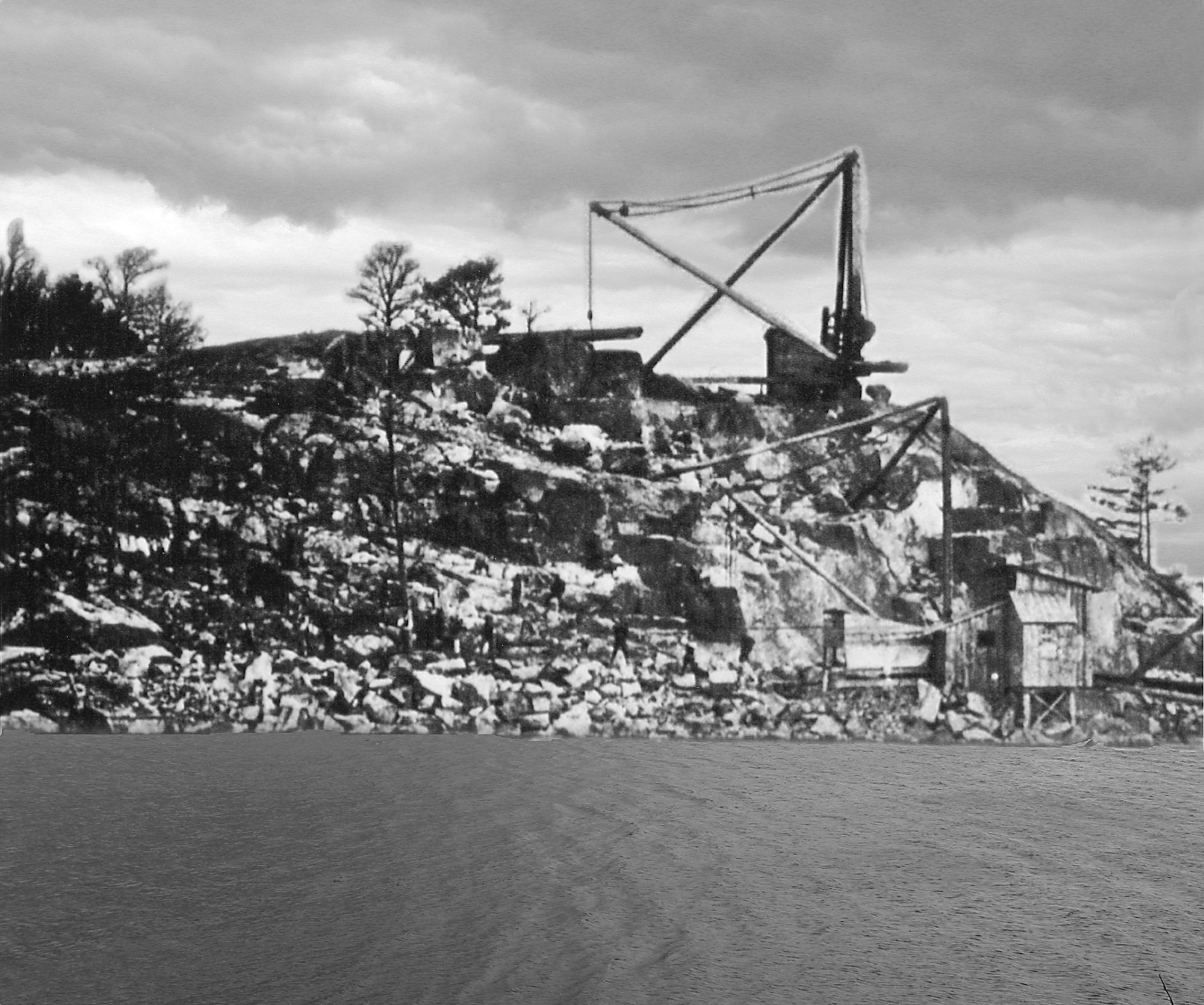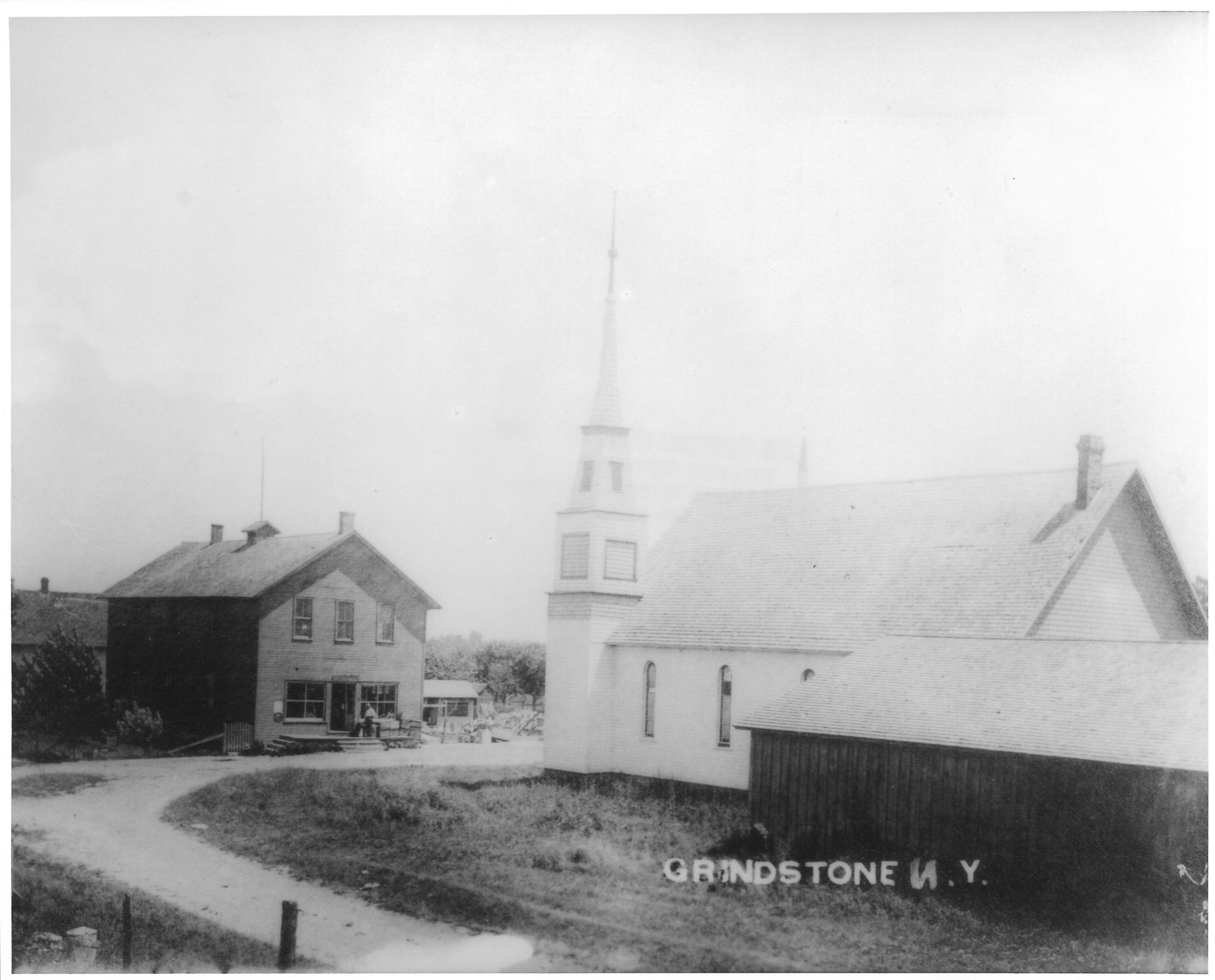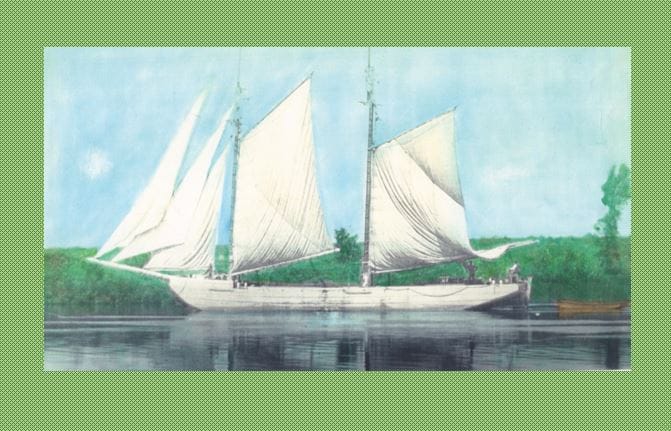Heyday of the Hay Scows
by: Richard Palmer
The Schooner Northern Light is shown getting underway at the Foster farm in Dexter, for a short voyage to Sackets Harbor. Originally owned by Captain William Shelley Sr., she was used to transport baled hay from surrounding farms, as well as fancy peas and beans in the area to the seed houses at Chaumont. She was later owned by Dexter Dibble of Sackets Harbor and was operated by his sons, Spencer and Sam. While loading gravel at Calf Island in November 1916, she broke loose from her mooring. She piled up on the bar of the south harbor on Galloo Island. A year later, during a sudden storm, she floated over the bar into the harbor and sank. Photo courtesy of the late Robert Brennan of Sackets Harbor.
Poking their way through the backwaters of Lake Ontario and the Upper St. Lawrence River, well into the 20th century, was a fleet of little schooner-rigged vessels that played an important role in commerce along the mainland and island shores of this region.
Although unceremoniously known as hay scows, these vessels were a product of their environment, floating supplies to the inhabitants of the many islands, and transporting farmers’ produce from the islands to market.
The late S. Kelsey Ainsworth said:
“I remember the day that we moved from Carleton Island (near Cape Vincent, off Wolfe Island) in one of those old hay scows, this being in the late fall. The morning was very cold, but the sun was shining, and by the time we finished our breakfast, the scow had landed and was ready to load our entire belongings, household furniture, and farm equipment. I am quite sure that the scow was named the Carleton and was sailed by Captain William Sheeley, Jr., and Preston Hollenbeck. They were both very anxious to get started because they said that there had been a rainbow in the sky early that morning, which was a sure indication of a near storm.”
“The loading of the scow was finally completed and ready to take off, but yours truly was nowhere to be found. After an hour’s search, they found me in an old smokehouse in which we kids used to play. The door was shut and I was sitting right in the middle of the dirt floor, crying my eyes out.”
“I was placed aboard the scow in no uncertain manner and down into the forecastle, or smelly but warm old cabin, and the scow got away without further delay. We had just rounded the east foot of the island when the storm broke right from the west and the farther we went, the more violent the storm. The men talked it over when about a mile and a half from Cape Vincent, they debated as to whether they had better try and make it, or turn back and try and to make Millen Bay Harbor.”
“They decided to go on, so my father called me up out of the cabin and said that in case something happened, I would stand a better chance floating around in that ice water than I would down in that nice warm cabin. After a fight of several hours, against one of the worst storms I have ever encountered on the water, we reached the depot dock at Cape Vincent at dark and the supper was never better or the bed never softer, than they were that night at the old Union House.”
Hay scows came in various sizes but always had what was known as a punt shape – both bow and stern – with a flat bottom, making it possible for them to back up close to shore. When not loaded, they would draw only a few inches of water. The stern deck was on hinges and would open right back onto the shore in the same manner as the tailgate on a pick-up truck. This made it easy to drive cattle, sheep, hogs, or horses into the scow, or wheel on baled hay, grain, sand, or gravel.
Usually, just prior to this kind of landing, they would drop a kedge anchor about 75 or 100 feet from shore. When loading in shallow water it would become necessary to shorten the kedge anchor chain and keep moving the scow out from the shore into deeper water so the scow would not ground on the bottom. As the scow moved out, they would place the stern deck back into place and wheel the balance of the load out on long heavy planks. A load of baled hay would not only fill the hold but would extend from four to six feet above the deck. If the weather was bad, the deck load would be covered with heavy canvas tarps to prevent the spray from soaking the hay.

Identifying the scow
The river scow usually had one mast with a main sail, a topsail, and one or two jibs. However, there were also larger schooners, such as the Northern Light, which also were classed as river scows. The bow deck usually extended back to the mast and had a wide running-board on either side that extended back to the stern. This connected with the stern deck where the helmsman stood and guided the boat with a long sweeping helm. The cabin, or forecastle, was just in front of the mast, beneath the front deck. It was accessible only through a companionway or sort of trap door, and down a ladder.
The snug cabin was usually equipped with two or three bunks, a small stove (bolted to the floor), blankets, oil skins, rubber boots, lanterns, oil, and a few cooking utensils. The sea-stores consisted of a couple of loaves of bread, a peck of potatoes, a jug of black molasses, a can of coffee, and a slab of bacon or salt pork. The Northern Light, which was built at the Phelps shipyard at Chaumont, was mastered by Captain William Sheeley, Sr. Another schooner-scow, the Denver, was built at Grindstone Island near Clayton, NY. The Denver was considered a good vessel and changed hands many times. Her owners included Sam Wenborn, Martin Bates, and John Fitzgerald.
Getting to Market
To encourage Canadian farmers to sell their hay in New York and Boston, the New York Central Railroad reduced freight shipping rates by 50 cents a ton on all water hay. In addition to Canadians, many farmers living in Jefferson County, near the lake or the River, would scow their hay to Cape Vincent, instead of hauling it a greater distance over the very rough country roads.
There were two large seed houses at Cape Vincent, and one at Chaumont. Fancy peas and beans were favorite crops in the those days, and scows did a good business every fall transporting the yield. When bean weevils and pea bugs made raising these crops unprofitable, farmers seeded hay and raised cattle, thus using their own hay. The hay scows then brought pulpwood and lumber from Canada to Dexter, NY, and other villages on the American side.
Ainsworth said: “The first scow I remember having seen was a small one owned by Captain Coleman Hinckley, Sr., and this was the smartest scow I have ever seen. Many a good yachtsman found that he had underestimated the little scow when he tried to beat into the mouth of the River. To be a good scow man was a real art, and there was much strife between captains. I heard many a farmer said Captain Hinckley could land, load, and get away while some of the others were still making a landing.”
“The Ferry was the correct name of that little scow, but I remember that due to its fleetness and the fact that it was always occupied, some village wags dubbed it the Pick Where She Scratches.”
Scows along the Upper St. Lawrence River
At one time, there were a large number of scows along the upper St. Lawrence River, built at many different places, including Sackets Harbor, Chaumont, Cape Vincent, and Clayton. Several were built at the Slate Brothers Shipyard on Grindstone Island. Among them, the Allie C, which for many years was owned by Captain Eugene Fitzgerald of Cape Vincent. She was remembered as a “smart little scow.”
The scow Myra was built and owned by Captain T. Brewster, a ship carpenter who built many fine, heavy skiffs. A number of scows were also owned on Grindstone Island, including the Olive Branch, owned by Captain James Carnegie.
A story was told concerning the owner of the Crazy Boy, which was owned at one time in Cape Vincent. One day, having nothing better to do, he decided to paint the name on both sides of the scow. So, while laying on his stomach looking down, he discovered he had painted the name bottom side up. According to local folklore, he had done such a good job of lettering, he decided to leave it that way.


The small community of Thurso, on the north side of Grindstone Island, had a general store, post office, large boarding house, hotel, and church. Thurso boomed for a while and was a regular stop for the scows. It owed its existence to the Forsythe Red Granite Quarries that furnished paving blocks, which were freighted to Chicago and other upper lake cities for paving streets. Every man at Thurso earned what were considered big wages for those days.
Ainsworth recalled: “I was running a branch music store at Cape Vincent for R.J. McDowell of Kingston, ON, and we would load our team and piano wagon into the scow Allie C. We’d then load on a dozen or more pianos and organs, go down to Thurso, unload them in a stone shed on the dock, and send the scow back home. We would stay on the island until we had sold out and then we would load our team and wagon into the scow Olive Branch and Captain James Carnegie would land us at Clayton dock, to drive back home.”
Redesigned for Power
Eventually, the gasoline engine came into general use; that in turn led to development of small power boats, which became numerous on the River. The scowmen took advantage of these and used power boats to haul their scows. This was the beginning of the end of the age of sail because a power boat would do the work regardless of how the wind was blowing. Scows were then re-designed. The punt shape was retained, minus mast and sails. Completely decked over to carry the entire load on deck, it was propelled by a power boat lashed alongside. For quite a few years, the flat scow did a great business in boating baled hay and other commodities. This business, however, was short lived.
When the automobile displaced horsepower and heavy trucks sent draft farm horses to pasture, the New York and Boston hay and grain markets disappeared. The march of time consumed the colorful hay scows and changed the whole picture of agriculture in the North Country. Long gone are the informal days, when the scows also provided public transportation among the Thousand Islands, with the waving of a handkerchief or blowing of a horn.
By Richard F. Palmer
Richard F. Palmer is a retired newspaper editor and reporter, and was well known for his weekly historical columns for the “Oswego Palladium-Times”, called "On the Waterfront." His first article for TI Life was written in January 2015 and since then, he has written a dozen-plus others. He is a voracious researcher, and TI Life readers benefit from his interesting findings. Click here to see some of Richard Palmer’s TI Life Articles.
Editor's Note: Appreciation to the Grindstone Island Research and Heritage Center for assisting with photographs.






Please click here if you are unable to post your comment.